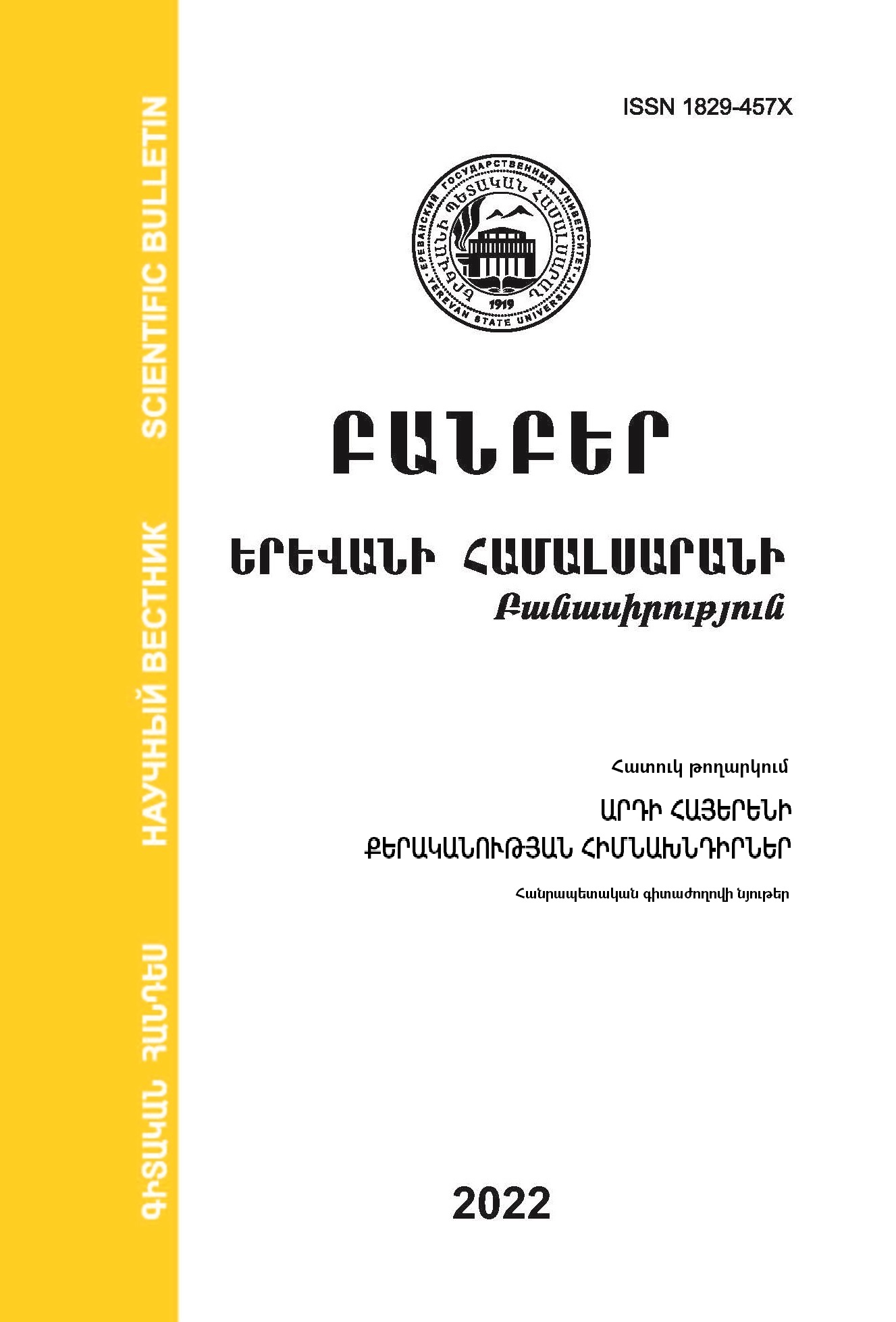Morphological Notes in Modern Armenian Orthographic, Definition and Meaning Dictionaries
DOI:
https://doi.org/10.46991/BYSU:B/2022.sp2.015Keywords:
grammar dictionary, morphological notes, inconsistencies, defective verbs, definition and meaning dictionary, the morphological norm of modern Eastern ArmenianAbstract
In contrast to the rich variety of theoretical works, we have not used the practical method of morphology, in particular, the dictionary entry. To this day, we haven’t had a grammar dictionary of Armenian.
Considering the current state of the problem, it has been planned to compile and publish such a work – "Educational Grammar Dictionary of Modern Easter Armenian.”
Undoubtedly, Armenian lexicography has centuries-old traditions. Encyclopedic and linguistic dictionaries such as the “New Dictionary of the Haikazian Language” by the Mkhitaryan fathers, H. Acharyan's “Armenian Derivational Dictionary” and "Dictionary of Armenian Personal Names,” H. Barseghyan's “Armenian Orthographic Otrthoepical Terminological Dictionary,” “Explanatory Dictionary of the Modern Armenian Language” in 4 volumes, Ed. Aghayan's "Explanatory Dictionary of Modern Armenian,” A. Sukiasyan, S. Galstyan's “Phraseological Dictionary of the Armenian Language,” A. Sukiasyan's "Dictionary of Synonyms of the Armenian Language" and others published in 19th-20th centuries have had an inestimable linguistic value.
Still, there is a wide variety of lexicographic directions: explanatory, orthographic, morphological, phraseological, synonym, neologism, foreign words, their equivalents, dialects, and abbreviation dictionaries.
However, these dictionaries are primarily lexical in nature and provide an epistemological description of lexical composition. Such dictionaries will have their effective continuation. Nevertheless, linguistic dictionaries have other missions, too, one of which is the dictionary description of the grammar of the literary language, particularly that of its morphology. Anyway, since the 1950s, such dictionaries have been compiled for English, French, and Russian, while in Armenian, strictly private grammar instructions have been found in explanatory, orthographic dictionaries for the time being.
References
Ստ. Պալասանյան, Ընդհանուր տեսութիւն արեւելեան նոր գրաւոր լեզուի հայոց, Թիֆլիս, 1870, Քերականութիւն մայրենի լեզուի հայոց, Թիֆլիս, 1874,
Հ. Աճառյան, Լիակատար քերականություն հայոց լեզվի` համեմատությամբ 562 լեզուների, Եր․, 1955-1971,
Մ. Աբեղյան, Հայոց լեզվի տեսություն, Եր., 1965, Գ. Սևակ, Ժամանակակից հայոց լեզվի դասընթաց, Եր., 1955,
Հ. Բարսեղյան, Արդի հայերենի բայի և խոնարհման տեսություն», Եր., 1953, Հայերենի խոսքի մասերի ուսմունքը, Եր., 1980,
Գ. Ջահուկյան, Հայոց լեզվի տեսության հիմունքները, Եր., 1974, Մ. Ասատրյան, Ժամանակակից հայերենի ձևաբանության հարցեր, 3 հ., Եր., 1970-77, Ժամանակակից հայոց լեզու. ձևաբանություն, Եր., 1983,
Ա. Մարգարյան, Հայերենի հոլովները, Եր., 2000, Հայոց լեզվի քերականություն․ ձևաբանություն, Եր., 2004,
Լ. Խաչատրյան, Բառակազմական և ձևաբանական կաղապարները ժամանակակից հայերենում, Եր., 2014,
Ստ. Մալխասեանց, Հայերէն բացատրական բառարան, Եր., 1944, էջ ԺԷ,
«Ժամանակակից հայոց լեզվի բացատրական բառարան», Եր., 1969, էջ VIII,
Հ. Բարսեղյան, Հայերեն ուղղագրական-ուղղա¬խոսական, տերմինաբանական բա¬ռարան, Եր., 1973, էջ IX:
Downloads
Published
How to Cite
Issue
Section
License
Copyright (c) 2022 Bulletin of Yerevan University

This work is licensed under a Creative Commons Attribution-NonCommercial 4.0 International License.

